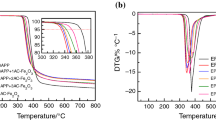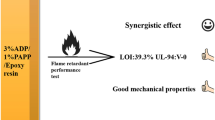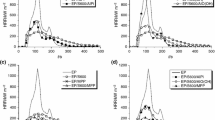Abstract
Bio-based flame retardant magnesium phytate (Mg-Phyt) was synthesized by a facile chelation reaction and characterized. The feasibility of Mg-Phyt as flame retardant for epoxy resins was studied. In order to enhance its flame retardancy, the synergistic flame retardancy between Mg-Phyt and agricultural waste material rice husk ash (RHS) and the synergistic effects of different ratios of these two were investigated. The results show that the addition of 10 mass% Mg-Phyt can reduce the thermal decomposition rate and achieve good flame retardant performance for epoxy resins. Furthermore, the combination of Mg-Phyt with RHS can have a synergistic flame retardant effect. Among them, the synergistic effect of 5 mass% Mg-Phyt and 5 mass% RHS is the best when the two substances are added into epoxy resins. More specifically, compared to pure epoxy resins, the peak heat release rate, total heat release, peak smoke production rate, and total smoke release of epoxy resins with 5 mass% Mg-Phyt and 5 mass% RHS are reduced remarkably by 28.6%, 10.6%, 33.0%, and 7.8%, respectively. The burning rate is also reduced by 42.4%. During the combustion process, this synergistic flame retardant effect is attributed to the formation of a compact silica-rich char layer containing Si–P and P–O–C structures with strong thermal stability to hinder the heat transfer into the epoxy resins substrate and reduce flammable gas emission, so that a better flame retardancy and smoke suppression of epoxy resins can be attained.











Similar content being viewed by others
References
Yan L, Xu Z, Deng N, Chu Z. Synergistic effects of mono-component intumescent flame retardant grafted with carbon black on flame retardancy and smoke suppression properties of epoxy resins. J Therm Anal Calorim. 2019;138(2):915–27.
Liu L, Xu Y, Xu M, Li Z, Hu Y, Li B. Economical and facile synthesis of a highly efficient flame retardant for simultaneous improvement of fire retardancy, smoke suppression and moisture resistance of epoxy resins. Compos Part B Eng. 2019;167:422–33.
Mariappan T, Wilkie J. Flame retardant epoxy resin for electrical and electronic applications. Fire Mater. 2014;38:588–98.
Anurag Y, Amit K, Kamal S, Manoj KS. Investigating the effects of amine functionalized graphene on the mechanical properties of epoxy nanocomposites. Mater Today. 2019;11:837–42.
Song Q, Wu H, Liu H, Han X, Qu H, Xu J. Synergistic flame-retardant effects of ammonium polyphosphate and AC-Fe2O3 in epoxy resin. J Therm Anal Calorim. 2019;138(2):1259–67.
Zhang Y, Yu B, Wang B, Liew KM, Song L, Wang C, Hu Y. Highly effective P-P synergy of a novel DOPO-based flame retardant for epoxy resin. Ind Eng Chem Res. 2017;56:1245–55.
Lu S, Hamerton I. Recent developments in the chemistry of halogen-free flame retardant polymers. Prog Polym Sci. 2002;27:1661–712.
Ma C, Yu B, Hong N, Pan Y, Hu W, Hu Y. Facile synthesis of a highly efficient, halogen-free, and intumescent flame retardant for epoxy resins: thermal properties, combustion behaviors, and flame-retardant mechanisms. Ind Eng Chem Res. 2016;55:10868–79.
Rakotomalala M, Wagner S, Doring M. Recent developments in halogen free flame retardants for epoxy resins for electrical and electronic applications. Materials. 2010;3:4300–27.
Schartel B. Phosphorus-based flame retardancy mechanisms-old hat or a starting point for future development? Materials. 2010;3:4710–45.
Qin ZL, Li D, Yang R. Study on inorganic modified ammonium polyphosphate with precipitation method and its effect in flame retardant polypropylene. Polym Degrad Stab. 2016;126:117–24.
Cheng X, Shi W. Synthesis and thermal properties of silicon-containing epoxy resin used for UV-curable flame-retardant coatings. J Therm Anal Calorim. 2011;103(1):303–10.
Murat S, Dilem S, Dogan M. Comparative study of boron compounds and aluminum trihydroxide as flame retardant additives in epoxy resin. Polym Adv Technol. 2014;25:769–76.
Zhang JH, Kong QH, Wang DY. Simultaneously improving the fire safety and mechanical properties of epoxy resin with Fe-CNTs via large-scale preparation. J Mater Chem A. 2018;6(15):6376–86.
Ding JM, Zhang Y, Zhang X, Kong QH, Zhang JH, Liu H, Zhang F. Improving the flame-retardant efficiency of layered double hydroxide with disodium phenylphosphate for epoxy resin. J Therm Anal Calorim. 2020;140(1):149–56.
Kong QH, Wu T, Zhang HK, Zhang Y, Zhang MM, Si TY, Yang L, Zhang JH. Improving flame retardancy of IFR/PP composites through the synergistic effect of organic montmorillonite intercalation cobalt hydroxides modified by acidified chitosan. Appl Clay Sci. 2017;146:230–7.
Qian L, Qiu Y, Wang J, Wang X. High-performance flame retardancy by char-cage hindering and free radical quenching effects in epoxy thermosets. Polymer. 2015;68:262–9.
Yang S, Zhang Q, Hu Y. Synthesis of a novel flame retardant containing phosphorus, nitrogen and boron and its application in flame-retardant epoxy resin. Polym Degrad Stab. 2016;133:358–66.
Kong QH, Sun YL, Zhang CJ, Guan HM, Zhang JH, Wang DY, Zhang F. Ultrathin iron phenyl phosphonate nanosheets with appropriate thermal stability for improving fire safety in epoxy. Compos Sci Technol. 2019;182:107748.
Ren H, Sun J, Wu B, Zhou Q. Synthesis and properties of a phosphorus-containing flame retardant epoxy resin based on bisphenoxy (3-hydroxy) phenyl phosphine oxide. Polym Degrad Stab. 2007;92:956–61.
Alexander S, Sebastian S, Wiebke L, Olaf W, Manfred D. Synthesis and properties of flame-retardant epoxy resins based on DOPO and one of its analog DPPO. J Appl Polym Sci. 2008;105:685–96.
Perret B, Schartel B, Stoss K, Ciesielski M, Diederichs J, Doring M, Krämer J, Altstädt V. Novel DOPO-based flame retardants in high-performance carbon fibre epoxy composites for aviation. Eur Polym J. 2011;47:1081–9.
Salmeia KA, Gaan SJ. An overview of some recent advances in DOPO derivatives: chemistry and flame retardant applications. Polym Degrad Stab. 2015;113:119–34.
Zhao C, Li Y, Xing Y, He D, Yue J. Flame retardant and mechanical properties of epoxy composites containing APP-PSt core-shell microspheres. Appl Polym Sci. 2014;131(9):40218.
Tan Y, Shao Z, Yu L, Xu Y, Rao W, Chen L, Wang Y. Polyethyleneimine modified ammonium polyphosphate toward polyamine-hardener for epoxy resin: thermal stability, flame retardance and smoke suppression. Polym Degrad Stab. 2016;131:62–70.
Zhang Z, Ma Z, Leng Q, Wang Y. Eco-friendly flame retardant coating deposited on cotton fabrics from bio-based chitosan, phytic acid and divalent metal ions. Int J Biol Macromol. 2019;140:303–10.
Yang W, Tawiah B, Yu C, Qian Y, Wang L, Yuen ACY, Zhu SE, Hu EZ, Chen TBY, Yu B, Lu H. Manufacturing, mechanical and flame retardant properties of poly(lactic acid) biocomposites based on calcium magnesium phytate and carbon nanotubes. Compos Part A Appl Sci Manuf. 2018;110:227–36.
Cheng L, Wu W, Meng W, Xu S, Han H, Yu Y, Qu H, Xu J. Application of metallic phytates to poly(vinyl chloride) as efficient biobased phosphorous flame retardants. J Appl Polym Sci. 2018;135(33):46601.
Costesab L, Laoutida F, Dumazertc L, José-Marie L, Sylvain B, Christian D, Philippe D. Metallic phytates as efficient bio-based phosphorous flame retardant additives for poly(lactic acid). Polym Degrad Stab. 2015;119:217–27.
Attia NF, Lee SM, Kim HJ, Geckeler KE. Nanoporous carbon-templated silica nanoparticles: preparation, effect of different carbon precursors, and their hydrogen storage adsorption. Microporous Mesoporous Mater. 2013;173:139–46.
Saraswathy V, Hawon S. Corrosion performance of rice husk ash blended concrete. Constr Build Mater. 2007;21:1779–84.
Arora S, Kumar M, Kumar M. Preparation and thermal stability of poly(methyl methacrylate)/rice husk silica/triphenylphosphine nanocomposites: assessment of degradation mechanism using model-free kinetics. J Compos Mater. 2012;47:2027–38.
Almiron J, Roudet F, Duquesne S. Influence of volcanic ash, rice husk ash, and solid residue of catalytic pyrolysis on the flame-retardant properties of polypropylene composites. J Fire Sci. 2019;37:434–51.
Wu W, He H, Liu T, Wei R, Cao X, Sun Q, Venkatesh. Synergetic enhancement on flame retardancy by melamine phosphate modified lignin in rice husk ash filled P34HB biocomposites. Compos Sci Technol. 2018;168:246–54.
Liu Y, Chiu Y, Wu C. Preparation of silicon-/phosphorous-containing epoxy resins from the fusion process to bring a synergistic effect on improving the resins’ thermal stability and flame retardancy. J Appl Polym Sci. 2003;87(3):404–11.
He Z, Wayne H, Zhang T, Paul MB. Preparation and FT-IR characterization of metal phytate compounds. J Environ Qual. 2006;35:1319–28.
Xue Z, Zhang Y, Li G, Wang J, Zhao W, Mu T. Niobium phytate prepared from phytic acid and NbCl5: a highly efficient and heterogeneous acid catalyst. Catal Sci Technol. 2016;6:1070–6.
Sun P, Li Z, Song M, Wang S, Yin X, Wang Y. Preparation and characterization of zirconium phytate as a novel solid intermediate temperature proton conductor. Mater Lett. 2017;191:161–4.
Xu Y, Sun X, Shen R, Wang Z, Wang Q. Thermal behavior and smoke characteristics of glass/epoxy laminate and its foam core sandwich composite. J Therm Anal Calorim. 2020;141(3):1173–82.
Nour FA, Heshiam AA, Mohamed AH. Synergistic study of carbon nanotubes, rice husk ash and flame retardant materials on the flammability of polystyrene nanocomposites. Mater Today. 2015;2:3998–4005.
Liu Y, Wei W, Hsu KY, Ho WH. Thermal stability of epoxy-silica hybrid materials by thermogravimetric analysis. Thermochim Acta. 2004;412(1–2):139–47.
Shen R, Hatanaka LC, Ahmed L, Agnew RJ, Mannan MS, Wang Q. Cone calorimeter analysis of flame retardant poly(methyl methacrylate)-silica nanocomposites. J Therm Anal Calorim. 2017;128(3):1443–51.
Ahmed L, Zhang B, Shen R, Agnew RJ, Park H, Cheng Z, Mannan MS, Wang Q. Fire reaction properties of polystyrene-based nanocomposites using nanosilica and nanoclay as additives in cone calorimeter test. J Therm Anal Calorim. 2018;132(3):1853–65.
Xu Y, Lv C, Shen R, Wang Z, Wang Q. Experimental investigation of thermal properties and fire behavior of carbon/epoxy laminate and its foam core sandwich composite. J Therm Anal Calorim. 2019;136(3):1237–47.
Xu Y, Lv C, Shen R, Wang Z, Wang Q. Comparison of thermal and fire properties of carbon/epoxy laminate composites manufactured using two forming processes. Polym Compos. 2020;9(41):3778–86.
Zheng Z, Liu S, Wang B, Yang T, Cui X, Wang H. Preparation of a novel phosphorus- and nitrogen-containing flame retardant and its synergistic effect in the intumescent flame-retarding polypropylene system. Polym Compos. 2015;36:1606–19.
Chen Z, Jiang M, Chen Z, Chen T, Yu Y, Jiang J. Preparation and characterization of a microencapsulated flame retardant and its flame-retardant mechanism in unsaturated polyester resins. Powder Technol. 2019;354:71–81.
Zhao C, Liu Y, Wang D, Wang D, Wang Y. Synergistic effect of ammonium polyphosphate and layered double hydroxide on flame retardant properties of poly(vinyl alcohol). Polym Degrad Stab. 2008;93:1323–31.
Bettina D, Karen AW, Daniel H, Rolf M, Bernhard S. Flame retardancy through carbon nanomaterials: carbon black, multiwall nanotubes, expanded graphite, multi-layer graphene and graphene in polypropylene. Polym Degrad Stab. 2013;98:1495–505.
Liu Y, Zhao J, Deng C, Chen L, Wang D, Wang Y. Flame-retardant effect of sepiolite on an intumescent flame-retardant polypropylene system. Ind Eng Chem Res. 2011;50:2047–54.
Chen J, Zhu J. A query on the Mg 2p binding energy of MgO. Res Chem Intermed. 2019;45:947–50.
Gao Y, Deng C, Du Y, Huang S, Wang Y. A novel bio-based flame retardant for polypropylene from phytic acid. Polym Degrad Stab. 2019;161:298–308.
Feng C, Liang M, Zhang Y, Jiang J, Huang J, Liu H. Synergistic effect of lanthanum oxide on the flame retardant properties and mechanism of an intumescent flame retardant PLA composites. J Anal Appl Pyrol. 2016;122:241–8.
Chen W, Liu Y, Liu Y, Wang Q. Preparation of alginate flame retardant containing P and Si and its flame retardancy in epoxy resin. J Appl Polym Sci. 2017;134(48):45552.
Richard HT, Artur W, Luke H. Fire retardant action of mineral fillers. Polym Degrad Stab. 2011;96:1462–9.
Baine P, Khor YC, Gamble HS, Armstrong BM, Mitchell SJN. Novel materials for thermal via incorporation into SOI structures. J Mater Sci Mater Eectron. 2001;12:215–8.
Acknowledgements
This work was financially supported by the Scientific Research Project of Liaoning Provincial Department of Education (JYT19065), and Natural Science Foundation of Liaoning Province (No. 20180540033).
Author information
Authors and Affiliations
Corresponding author
Additional information
Publisher's Note
Springer Nature remains neutral with regard to jurisdictional claims in published maps and institutional affiliations.
Rights and permissions
About this article
Cite this article
Xu, Y., Li, J., Shen, R. et al. Experimental study on the synergistic flame retardant effect of bio-based magnesium phytate and rice husk ash on epoxy resins. J Therm Anal Calorim 146, 153–164 (2021). https://doi.org/10.1007/s10973-020-10420-8
Received:
Accepted:
Published:
Issue Date:
DOI: https://doi.org/10.1007/s10973-020-10420-8




